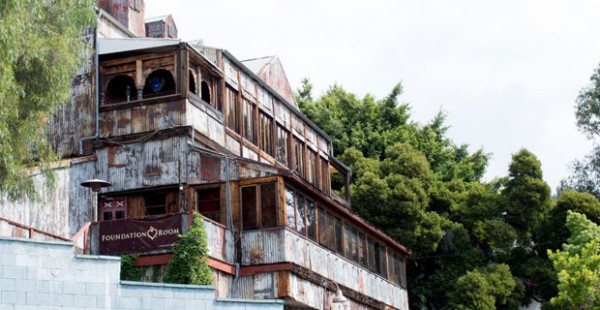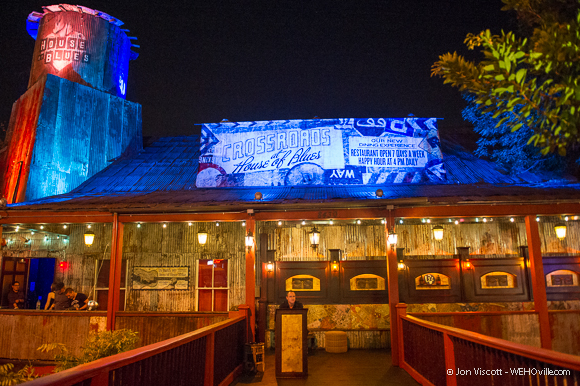
The long-anticipated demolition of the House of Blues began this morning.
A crew of workers with a large demolition machine had ripped off the rear of the famed rock venue by 8 a.m. this morning. Workers on the site said they expect the demolition to last several weeks.
The House of Blues, which sits on the southeast corner of Sunset Boulevard and Olive Drive, is known for having hosted the likes of Eric Clapton, Aretha Franklin, Stevie Wonder, Prince, Aerosmith and Justin Timberlake. It is also one of the most eclectic museums in a creative city that can claim few.
It will be replaced by Sunset Time, a major hotel and residential project by Combined Properties. The project will extend from Sunset Boulevard south to Fountain Avenue. Facing Sunset Boulevard will be an eight-story hotel known as the Pendry with 149 guest rooms, shops and a restaurant and bar. Fronting Olive Drive and Fountain Avenue will be a 45-unit five-story condo building. The hotel building incorporates a 6,000 square-foot digital sign into its facade.
Every inch of every wall, door and ceiling in the 40,000 square foot House of Blues club and restaurant had a story, all collected by Isaac Tigrett. Tigrett is a Nashville native who got his start in the music business while living in London as what his biography describes as a “revolutionary hippie activist.”
Tigrett and his business partner, Dan Akyroyd, opened the West Hollywood venue in 1994, the third of what are now 12 House of Blues clubs owned by Live Nation.
In an interview with West Hollywood Magazine in 2015, Michael Grozier, a Live Nation executive who has worked with the House of Blues since 1994, said it hoped to conserve the massive collection of folk and Indian art inside.

“I think we’re going to try to do our best to hold onto everything,” Grozier said. “We may auction some things for charity. It’s kind of a bittersweet thing to think about. The plan is to relocate in Los Angeles. We’d love to stay in West Hollywood but there’s no space.”
There is a story behind everything West Hollywood is losing with with the demolition of the building, including the metal-clad exterior. That corrugated metal once was wrapped around a building at the Devil’s Crossroads, the intersection of Highways 49 and 61 in Clarksdale, Mississippi. It was inside that building where early blues legend Robert Johnson is said to have kneeled and offered his soul to the devil. Workers on the demolition site today said the corrugated metal will be recycled.
The top floor of the House of Blues building offered testament to Tigrett’s passion for Indian mysticism. It was his Indian guru, Sathya Sai Baba, who he credits for his decision to develop the House of Blues. “He told Isaac that the Hard Rock was high school. The House of Blues was college,” Grozier said. The top floor also housed the Foundation Room, a members-only restaurant and lounge whose profits support the House of Blues Foundation. The walls were covered with exotic and ancient Indian fabrics, the ceilings with sculpted material rescued from buildings hundreds of years old, and the bar railings are made from pieces from ancient Indian temples. Perhaps the most intimate of the spaces was the Ganesh room, which contains a statue of the elephant-headed Indian god for which it is named.
The second floor was inspired in part by Juke Joint, photographer Birney Imes’ collection of images from black dance halls and bars in rural Mississippi. The folk art on the walls, Tigrett felt, reinforced the history of the blues and the impact of that genre on rock and other music forms that have followed. “The blues are the roots and the other musics are the fruits,” Grovier said, quoting blues artist Willie Dixon.
The art there includes work such as “Devil Fishing” by Leroy Almon, the Georgia folk artist whose work centered around social and religious themes. Almon carved each work out of wood before painting it. Another artist featured on the second floor was Jimmy Lee Sudduth, also a blues musician. Sudduth lived in poverty in a shotgun house in rural Alabama and created much of his early work from pigments he made from mud mixed with house paint and motor oil. Work by Ray Ferdinand portrayed life on the streets of New Orleans.
Some of the most eye-catching works in the House of Blues were the Blues Gods by Andrew Wood. The House of Blues commissioned Wood to create 118 plaster relief portraits of blues and rock musicians that were on the ceilings of each of its venues.
The downstairs was dominated by a stage, over which arched the God Wall, featuring images from various religions to support the idea of unity in diversity. Nearly every part of the room was a work of folk art. For example, the bar nearby was decorated with beer bottle caps.
When the House of Blues opened, it was a catalyst for the revival of the Sunset Strip, the historic home of rock ‘n roll. But today the Sunset Boulevard’s nightclubs are giving way to hotels. Isaac Tigrett, who left the House of Blues in 1998, now lives in Andhra Pradesh in South India, working on a mystical teaching and healing center.


[…] Britely Social Club on the Sunset Strip. (The new building was erected on the grounds of the old “House of Blues” property, 8430 Sunset […]
Perhaps no one has noticed but the demolition has included the buildings on the northeast corner of Fountain and Olive which means that the Commercial District is now encroaching on Fountain in a Residential District. A subtle little precedent and prediction that Jerome Nash made years ago theorizing that Fountain could become mixed use. And just who might benefit? Bingo!
The hotel will only extend partially down Olive Dr. towards Fountain. The rest of the project including at Olive Dr. and Fountain are going to be Condo’s.
If the House of Blues had been a thriving business… it would still be a thriving business.
It was Disney with drunks and bouncers.
BillH, The HOB CUP when originally opened was for a Supper Club. It only lasted a few months. That is why there was so little parking. The fiasco didn’t work out and they had their CUP changed to a Night Club with the understanding they would build additional parking since their new CUP increased the amount of patrons allowed inside. That never happened. I live just south of the HOB and observed the low life exiting the club each night and walking down Olive Dr. to wherever they parked their cars. It was very common to hear them fighting, yelling… Read more »
They say you can’t stop progress. Funny their definition of the word.
This is a perfect example of the incompetent West Hollywood city counsel members. (especially John Heilman) Heilman has been a counsel member since the plans to build the legendary “House of Blues”. To go through all that trouble, permits, business licenses and build a successful business just to turn around and demolish the whole unique architecture of the “House of Blues” 15 years later makes no sense? John is a lawyer and studied law, got his degree…… One would think he would not be so stupid. Just goes to show you a degree means nothing RE smarts.
George, first off the HOB was built 21 years ago, second, please explain how Heilman single handedly is responsible for this.
George Hirst, the club was not successful and that’s why it closed down. It was built as a supper club and that failed so they were given permission to change it into an entertainment venue/night club. Per what I have been told there were insufficient dressing rooms and other needed phystlities that made it impractical to remain open. And if someone wants to go thru the problems of construction and permits and the business fails it’s not the cities problem or John Heilman’s.
L.A. is getting uglier by the day.A wasteland with empty Mcmansions and homeless encampments.
So sad to see this. Loved all the secret rooms and art and most of all the music. Where do all the hotel guests go for entertainment?
The guests can go to REAL rock clubs like the Whiskey or the Troubador,etc.
The new hotel will be ironically possessed by the Devil. Many Deaths will occur due to the dirt spirit of the prior occupancy.
Surely the area has enough hotels and condos. What will be the next place to go?
I will always remember being in the elevator at the HOB with just a friend of mine and the great singer Tammy Wynette.
Many other great memories their.
Kinda sad to see a great venue for music in LA disappear. Saw ZZ Top about five years ago there. The show was a quickly put together show with an announcement made within 24 hours of the event. It sold out in minutes. Lots of surprise guest stars like John Mayer & Slash. What a night.